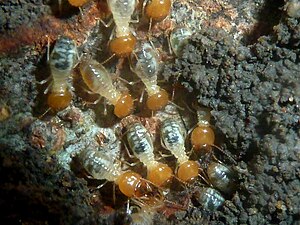Odontotermes
| Odontotermes | |
|---|---|

| |
| The alate, soldier, minor worker and queen of O. horni | |
| Scientific classification | |
| Domain: | Eukaryota |
| Kingdom: | Animalia |
| Phylum: | Arthropoda |
| Class: | Insecta |
| Order: | Blattodea |
| Infraorder: | Isoptera |
| Family: | Termitidae |
| Subfamily: | Macrotermitinae |
| Genus: | Odontotermes Holmgren, 1912 |
Odontotermes is a termite genus belonging to subfamily Macrotermitinae (fungus-growing termites), which is native to the Old World. They are most destructive in wooden homes,[1] and are agricultural pests in the tropics and subtropics of Africa and Asia.[2] It is the most diverse termite genus in Africa, with 78 species recorded (as of 2002).[3]
Nests
[edit]Their underground nests form a slight mound above ground, which may be covered in grass.[1] In large colonies, the mounds may be up to 6 m (20 ft) in diameter, and may be covered by shrubs and trees. Some species construct open chimneys or vent holes that descend into the mound. The fungal garden is enveloped by a thick layer of clay.[1]
Castes
[edit]The queen lives in a clay cell in the midst of the fungal garden at the center of the hive. The African species have a single soldier caste, unlike the related genus Macrotermes.
Alarmed soldier termites of Odontotermes badius Haviland 1898 expel an odoriferous brown defensive secretion between their mandibles that becomes sticky and rubbery on exposure to air. The secretion is a mixture of benzoquinone and protein.[4]
Food
[edit]Their only food is the fungus grown in the fungal garden at the center of the nest. The fungus is cultivated on a substrate of wood, bark, leaf litter, dry dung, and dead grass.[1] These are plastered with cement where they are obtained, which facilitates diurnal foraging. Odontotermes species are major contributors to litter decomposition.[2] The fungus Termitomyces reticulatus is found in association with O. badius and O. transvaalensis in Africa.[5]
Species
[edit]Species include:
- Odontotermes assmuthi Holmgren, 1913 – South Asia
- Odontotermes badius (Haviland, 1898) – Africa
- Odontotermes ceylonicus (Wasmann, 1902) – South Asia
- Odontotermes escherichi Holmgren, 1911 – South Asia
- Odontotermes feae (Wasmann, 1896) – South Asia
- Odontotermes formosanus (Shiraki) – South Asia
- Odontotermes globicola (Wasmann, 1902) – South Asia
- Odontotermes horni (Wasmann, 1902) – South Asia
- Odontotermes koenigi (Desneux, 1906) – South Asia
- Odontotermes latericius (Haviland, 1898) – Africa
- Odontotermes obesus (Rambur) – South Asia
- Odontotermes preliminaris (Holmgren, 1911) – South Asia
- Odontotermes redemanni (Wasmann, 1893) – South Asia
- Odontotermes taprobanes (Walker, 1853) – South Asia
- Odontotermes transvaalensis (Sjöstedt, 1902) – Africa
- Odontotermes wallonensis Wasmann – South Asia
Gallery
[edit]-
O. badius worker
-
Cement plastered over tree bark
-
Workers foraging on tree bark under cement
-
Workers in ventilation tunnel
References
[edit]- ^ a b c d Picker, Mike; et al. (2004). Field Guide to Insects of South Africa. Cape Town: Struik Publishers. p. 56. ISBN 978-1-77007-061-5.
- ^ a b Chiu, Chun-I; Yeh, Hsin-Ting; Li, Pai-Ling; Kuo, Chih-Yu; Tsai, Ming-Jer; Li, Hou-Feng (17 September 2018). "Foraging phenology of the fungus-growing termite Odontotermes formosanus (Blattodea: Termitidae)". Environmental Entomology. 47 (6): 1509–1516. doi:10.1093/ee/nvy140. PMID 30239668.
- ^ Muvengwi, Justice (2017). Relationships between termite (Macrotermes) mound distribution, plant diversity and large mammalian herbivory patterns in Gonarezhou National Park, Zimbabwe (Thesis). hdl:10539/22729.
- ^ Wood, William F.; Truckenbrodt, W.; Meinwald, Jerrold (1975). "Chemistry of the Defensive Secretion from the African Termite Odontotermes badius". Annals of the Entomological Society of America. 68 (2): 359–360. doi:10.1093/aesa/68.2.359.
- ^ van der Westhuizen GCA; Eicker A. (1990). "Species of Termitomyces occurring in South Africa". Mycological Research. 94 (7): 923–37. doi:10.1016/S0953-7562(09)81306-3.




